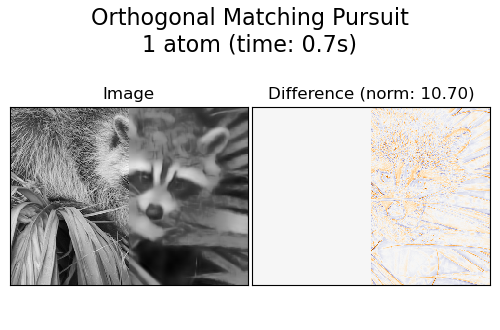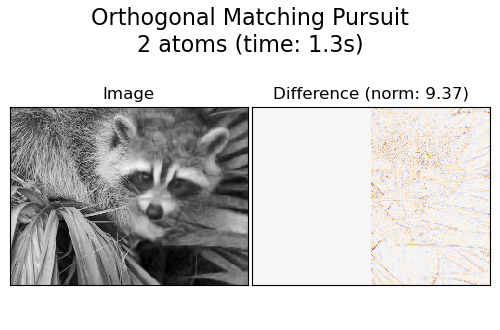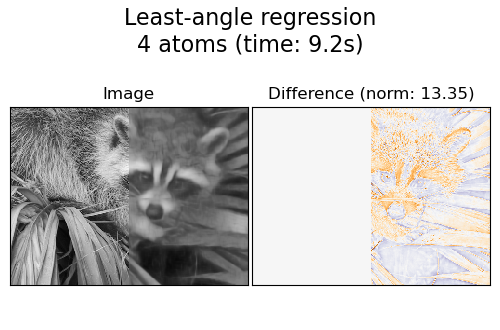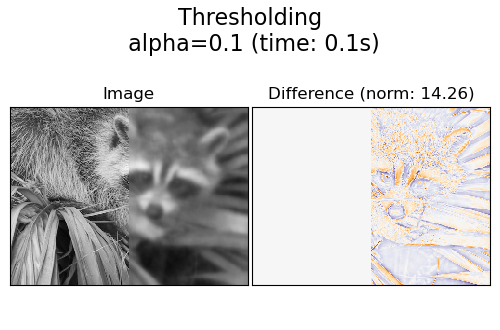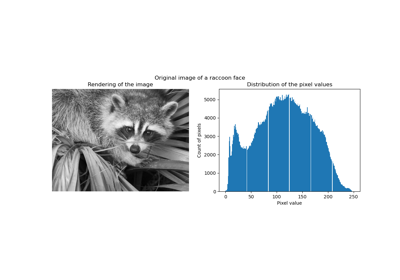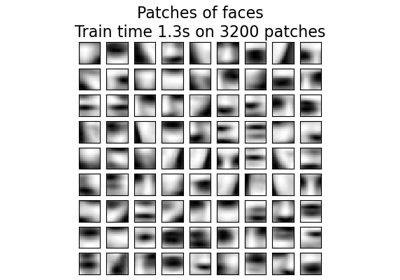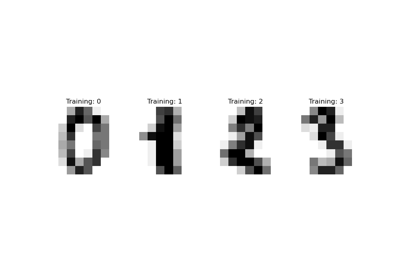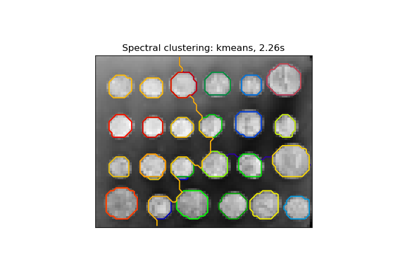注意
前往末尾 下载完整示例代码。或者通过 JupyterLite 或 Binder 在浏览器中运行此示例
图像去噪:使用字典学习#
一个示例,比较首先使用在线字典学习和各种变换方法重建浣熊面部图像噪声片段的效果。
字典在图像的扭曲左半部分进行拟合,然后用于重建右半部分。请注意,通过拟合未扭曲(即无噪声)图像可以实现更好的性能,但这里我们假设其不可用。
评估图像去噪结果的常见做法是查看重建图像与原始图像之间的差异。如果重建完美,这将看起来像高斯噪声。
从图中可以看出,使用两个非零系数的正交匹配追踪 (OMP)结果比只保留一个时(边缘看起来不那么突出)偏差略小。此外,它在 Frobenius 范数下更接近真实值。
最小角回归的结果偏差更大:差异让人联想到原始图像的局部强度值。
阈值处理显然不适用于去噪,但这里旨在展示它能以非常高的速度生成暗示性输出,因此可用于对象分类等其他任务,在这些任务中性能不一定与可视化相关。
# Authors: The scikit-learn developers
# SPDX-License-Identifier: BSD-3-Clause
生成失真图像#
import numpy as np
try: # Scipy >= 1.10
from scipy.datasets import face
except ImportError:
from scipy.misc import face
raccoon_face = face(gray=True)
# Convert from uint8 representation with values between 0 and 255 to
# a floating point representation with values between 0 and 1.
raccoon_face = raccoon_face / 255.0
# downsample for higher speed
raccoon_face = (
raccoon_face[::4, ::4]
+ raccoon_face[1::4, ::4]
+ raccoon_face[::4, 1::4]
+ raccoon_face[1::4, 1::4]
)
raccoon_face /= 4.0
height, width = raccoon_face.shape
# Distort the right half of the image
print("Distorting image...")
distorted = raccoon_face.copy()
distorted[:, width // 2 :] += 0.075 * np.random.randn(height, width // 2)
Distorting image...
显示失真图像#
import matplotlib.pyplot as plt
def show_with_diff(image, reference, title):
"""Helper function to display denoising"""
plt.figure(figsize=(5, 3.3))
plt.subplot(1, 2, 1)
plt.title("Image")
plt.imshow(image, vmin=0, vmax=1, cmap=plt.cm.gray, interpolation="nearest")
plt.xticks(())
plt.yticks(())
plt.subplot(1, 2, 2)
difference = image - reference
plt.title("Difference (norm: %.2f)" % np.sqrt(np.sum(difference**2)))
plt.imshow(
difference, vmin=-0.5, vmax=0.5, cmap=plt.cm.PuOr, interpolation="nearest"
)
plt.xticks(())
plt.yticks(())
plt.suptitle(title, size=16)
plt.subplots_adjust(0.02, 0.02, 0.98, 0.79, 0.02, 0.2)
show_with_diff(distorted, raccoon_face, "Distorted image")
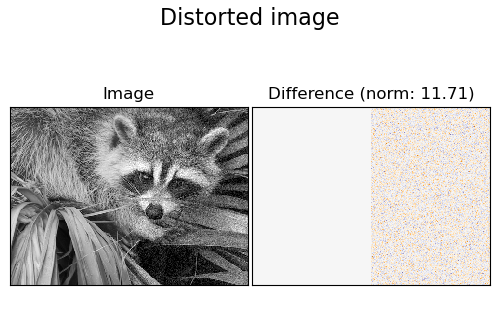
提取参考图像块#
from time import time
from sklearn.feature_extraction.image import extract_patches_2d
# Extract all reference patches from the left half of the image
print("Extracting reference patches...")
t0 = time()
patch_size = (7, 7)
data = extract_patches_2d(distorted[:, : width // 2], patch_size)
data = data.reshape(data.shape[0], -1)
data -= np.mean(data, axis=0)
data /= np.std(data, axis=0)
print(f"{data.shape[0]} patches extracted in %.2fs." % (time() - t0))
Extracting reference patches...
22692 patches extracted in 0.01s.
从参考图像块中学习字典#
from sklearn.decomposition import MiniBatchDictionaryLearning
print("Learning the dictionary...")
t0 = time()
dico = MiniBatchDictionaryLearning(
# increase to 300 for higher quality results at the cost of slower
# training times.
n_components=50,
batch_size=200,
alpha=1.0,
max_iter=10,
)
V = dico.fit(data).components_
dt = time() - t0
print(f"{dico.n_iter_} iterations / {dico.n_steps_} steps in {dt:.2f}.")
plt.figure(figsize=(4.2, 4))
for i, comp in enumerate(V[:100]):
plt.subplot(10, 10, i + 1)
plt.imshow(comp.reshape(patch_size), cmap=plt.cm.gray_r, interpolation="nearest")
plt.xticks(())
plt.yticks(())
plt.suptitle(
"Dictionary learned from face patches\n"
+ "Train time %.1fs on %d patches" % (dt, len(data)),
fontsize=16,
)
plt.subplots_adjust(0.08, 0.02, 0.92, 0.85, 0.08, 0.23)
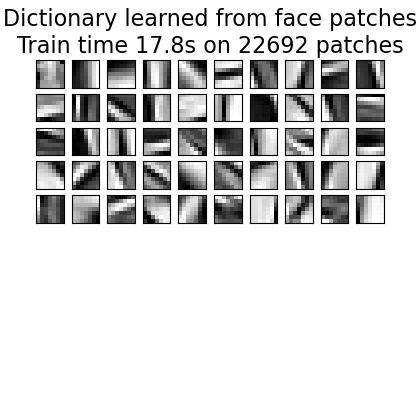
Learning the dictionary...
2.0 iterations / 125 steps in 14.16.
提取噪声图像块并使用字典重建它们#
from sklearn.feature_extraction.image import reconstruct_from_patches_2d
print("Extracting noisy patches... ")
t0 = time()
data = extract_patches_2d(distorted[:, width // 2 :], patch_size)
data = data.reshape(data.shape[0], -1)
intercept = np.mean(data, axis=0)
data -= intercept
print("done in %.2fs." % (time() - t0))
transform_algorithms = [
("Orthogonal Matching Pursuit\n1 atom", "omp", {"transform_n_nonzero_coefs": 1}),
("Orthogonal Matching Pursuit\n2 atoms", "omp", {"transform_n_nonzero_coefs": 2}),
("Least-angle regression\n4 atoms", "lars", {"transform_n_nonzero_coefs": 4}),
("Thresholding\n alpha=0.1", "threshold", {"transform_alpha": 0.1}),
]
reconstructions = {}
for title, transform_algorithm, kwargs in transform_algorithms:
print(title + "...")
reconstructions[title] = raccoon_face.copy()
t0 = time()
dico.set_params(transform_algorithm=transform_algorithm, **kwargs)
code = dico.transform(data)
patches = np.dot(code, V)
patches += intercept
patches = patches.reshape(len(data), *patch_size)
if transform_algorithm == "threshold":
patches -= patches.min()
patches /= patches.max()
reconstructions[title][:, width // 2 :] = reconstruct_from_patches_2d(
patches, (height, width // 2)
)
dt = time() - t0
print("done in %.2fs." % dt)
show_with_diff(reconstructions[title], raccoon_face, title + " (time: %.1fs)" % dt)
plt.show()
Extracting noisy patches...
done in 0.00s.
Orthogonal Matching Pursuit
1 atom...
done in 0.53s.
Orthogonal Matching Pursuit
2 atoms...
done in 1.09s.
Least-angle regression
4 atoms...
done in 8.05s.
Thresholding
alpha=0.1...
done in 0.09s.
脚本总运行时间: (0 分钟 25.050 秒)
相关示例

